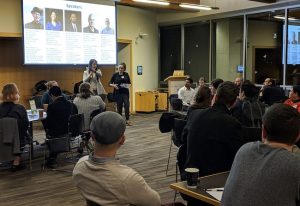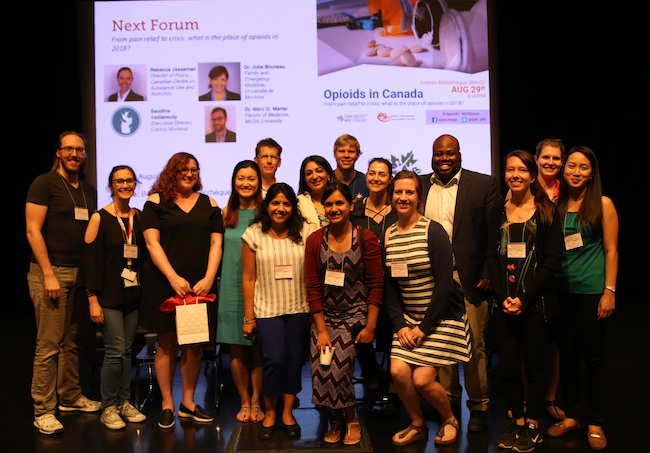Farah Qaiser, Policy & Politics co-editor, and Molly Sung, guest contributor
Science policy organizations come in all shapes and sizes, and range from think tanks, non-profits, and private firms to community and student groups. In a previous blog post, Science Borealis highlighted the efforts of a student science policy group, Science & Policy Exchange (SPE), which may have prompted you to wonder: What does it take to start a science policy group?
In this post, we’ll walk you through how to form a student science policy group and what we learned in our first year at the Toronto Science Policy Network (TSPN).
Step One: Narrow your focus
Science policy is a fairly broad term. It can involve science for policy (i.e., using science to inform policy) or policy for science (i.e., the allocation of resources to conduct research), and can be further broken down into advocacy, diplomacy, education, or pure policy initiatives. Your group can choose to remain broad in nature, or prioritize specific issues (e.g., the University of Toronto’s Aerospace Team has set up an Aerospace Policy Division).
Then, there’s the decision of what your group should be: will it be a university student group, or will you pursue the non-profit route instead?
It needn’t be overwhelming, however.
For us, it wasn’t a difficult decision, especially as there was no other student science policy group at the University of Toronto. We kept TSPN’s mission simple: to act as a platform where individuals – specifically undergraduate and graduate students and post-doctoral researchers – could learn about, and engage in, science policy. We chose to be a registeredstudent group to be eligible for funding through universitygrantssuch as the University of Toronto’s Student Initiative Fund.

The Science and Policy Integration Network (SPIN) hosted a ‘Potential of Pot!’ event, where they hosted a ‘living library’ of cannabis policy stakeholders (healthcare, academia, industry, youth education, and government). Credit: SPIN – used with permission.
On the other hand, both SPE and the Vancouver-based Science and Policy Integration Network (SPIN) are not-for-profits. SPE is a bilingual science advocacy group which aims to promote student voices in evidence-based decision-making, while SPIN is focused on enhancing science policy dialogues by promoting knowledge transfer between communities. Many U.S.-based science policy groups may also inspire you and give you some idea of what is possible.
Julienne Jagdeo, who is SPIN’s executive director, recommends that you “start by talking to those who have (or do) work in the policy realm. Understand how they utilize evidence-based knowledge in policy development, ask them what their challenges are when doing so, and discuss how you can support that process.”
There is no one answer when it comes to deciding what to focus on as a group. Here, it may be handy to recruit a faculty mentor – or a whole Board of Directors – to guide you through decisions like these.
Step Two: Find like-minded people and form a group
How do you go about finding – let alone recruiting – people passionate about science policy? It’s simple: Talk about it. Mention that you’re thinking of forming a student science policy group at a department seminar, tweet about it, and send out emails to different student groups and leaders to spread the word.
Although it may seem scary to share ideas so openly, putting the word out there can help garner interest and help you find like-minded people. And it works. Through word-of-mouth and social media, our TSPN co-founders (Sivani Baskaran, Ellen Gute, Vasa Lukich, Farah Qaiser and Molly Sung) met out of pure interest at a coffee shop in the summer of 2018 and decided to form a student science policy group.
Step Three: You have a mission – but how do you translate it into action?
With a mission in mind, you’re now ready to plan events. Events could range from skill-building workshops, lectures, and public panels, to more miscellaneous initiatives, such as writing policy memos in an Edit-A-Thon, taking part in stakeholder consultations, or engaging with local politicians and policy-makers. It all comes down to how you want to execute your mission.

The Science and Policy Exchange (SPE) team, consisting of both executives and volunteers, following a public forum on the Cannabis Act. Credit: Subhobrata Das – used with permission
Chances are, other groups in your area have similar interests. This isn’t a bad thing and it doesn’t mean you have to compete with each other for an audience. Find out how your missions overlap and figure out a way to collaborate. As a new organization, it can be difficult to navigate event planning and marketing, and so working with local libraries or science-outreach initiatives can help your group find its feet and even boost its exposure right out of the gate.
Step Four: Announce yourself!
Once you settle on a group name, snap up the relevant social media handles and set up a webpage. Twitter and Facebook aren’t just for sharing pictures of your cats – instead, “science Twitter” is a bustling place and a great way to announce your presence. Tagging local science communities and using hashtags like #scipol and #scicomm are great ways to announce events, get your message amplified, and make sure it reaches people in your area that might be interested.
If you’re based out of an institution, be sure to draft an email and reach out to relevant departments on campus. Many of them will be happy to pass along the message to their mailing lists. It’s also a great way to initiate working relationships that might lead to funding or collaborative opportunities down the road.
Step Five: Funding can make or break your organization
Even the best laid plans can’t be implemented without funding. As a student science policy group, your costs may include event catering, marketing, web hosting, securing audiovisual equipment, offering honorariums to speakers, and so on. How do you go about raising funds – especially as a new group?
At TSPN, we approached funding in many ways. We applied for university-based student grants and reached out to departments, student unions, course communities, and external organizations where appropriate. We approached potential partners with clear proposals (including a budget) that outlined how we would use funds to host events relevant to student learning and professional development.
Partnering is a win for both sides. As a student group, we gain the resources to host events, and the supporting group or department is able to provide their own audience or students with an event they otherwise may not have the bandwidth to organize themselves.
Sustainability is a critical concern when it comes to funding. Tina Gruosso, who is one of SPE’s two co-presidents, says that “[SPE’s] fundraising is mostly topical depending on the events we run – what is hard to find for us is a sustainable funding [source] to cover our (pretty low but still present) running costs, and ease the financial burden of being involved in such [an] organization [for] our volunteers.”
Step Six: Reflect on your successes and challenges as you grow
As a group, our first year was a big success. We met with a level of enthusiasm that none of us had expected, demonstrating that there was clearly a desire and need for a science policy group at the University of Toronto. We hosted workshops, public panels and other miscellaneous initiatives (such as a Wikipedia Edit-A-Thon), which were attended by over 200 scientists and members of the public.

The Toronto Science Policy Network (TSPN) team at the 2018 Canadian Science Policy Conference in Ottawa. From left to right: Sam McWhirter, Mireille Ghoussoub, Farah Qaiser, Dylan Glancy, Ellen Gute, James LaFortune, Molly Sung, Caroline Pao, Vasa Lukich and Sivani Baskaran. Credit: TSPN – used with permission
But we also had moments of struggle and stress. We didn’t have enough volunteers for the number of event attendees, so now we are working on establishing a robust team structure and recruiting a larger pool of volunteers.
It’s also noteworthy that our first public panel (on Ontario’s Sex Education curriculum) led to a heated discussion and generated more questions than we had time for. This event highlighted that we can’t please everyone. Instead we can only hope to execute our mission by providing a space for individuals to learn about, and engage in, science policy.
~
Overall, in forming a science policy group, we’ve learned a lot about the Canadian science policy landscape, and had the opportunity to contribute to national science policy conversations.
Today, there are only a few student science policy groups across Canada, so we’re calling on students to step up and lead these critical conversations.
This post is by no means a complete how-to guide on setting up a student science policy group, but we hope it helps illuminate your way forward.
~30~




